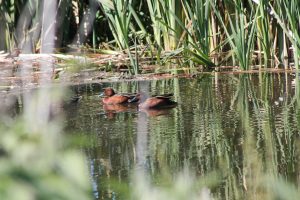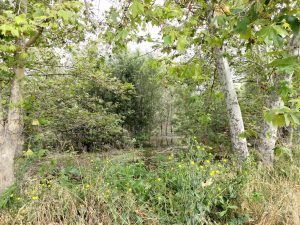The Santa Clara River, spanning across Ventura and Los Angeles counties, is a biologically rich region and is one of the few major river systems in California that retains much of its natural hydrology. The river provides the ecosystem functions necessary to support many federally listed species and State Species of Special Concern, including three endangered bird species; Least Bells’ Vireo (Vireo bellii pusillus), Southwestern Willow Flycatcher (Empidonax traillii extimus), and Western Yellow-billed Cuckoo (Coccyzus americanus occidentalis). The river basin also sustains some of the most valuable agricultural resources in the world. It provides water resources for surrounding urban populations, and provides diverse outdoor recreational opportunities.

Cinnamon Teal pair at Cienega Springs Ecological Reserve (CSER) in Fillmore, CA (©Dr. Linnea Hall)
The WFVZ Bird Museum and Research Center’s work on the river started in 2010 with annual monitoring of bird species densities and richness at the Hedrick Ranch Nature Area, managed by the Friends of the Santa Clara River (FSCR). Now, due to our continuous data collection, we have 15 years of data showing trends on the property! Since our work in 2010, we have expanded our projects to include regular annual monitoring and point counts of endangered Least Bell’s Vireo and other bird species populations and nests at multiple locations, including on Nature Conservancy (TNC) and California Department of Fish and Wildlife (CDFW) properties on the river. We have also conducted evaluations of Brown-headed Cowbird (Molothrus ater) parasitism, surveys and habitat modeling for Yellow-billed Cuckoo and Southwestern Willow Flycatcher, bird nest box monitoring, and regular population estimation of all riparian breeding birds on 17 TNC properties on the river. A particularly satisfying part of our work most recently (since 2016) has been to monitor nesting and other demographic responses of birds to riparian woodland restoration on several properties on the river. Since 2021 we also collected data on LBVI population size across the entire Santa Clara River for the US Fish and Wildlife Service (USFWS), completing this project in 2025!

Hedrick Ranch Nature Area
Today, we continue to monitor LBVI nests on TNC and CDFW properties, most recently (2019-2025) at our main research site, Cienega Springs Ecological Reserve (CSER), managed by the CDFW, in Fillmore. This site is actively being restored to a riparian woodland by UC Santa Barbara (UCSB)and other partners and will soon be open to the public! We are also continuing to conduct bird point counts along the river as well as monitoring other bird species nests on our research sites and surveying for Southwestern Willow Flycatchers and Western Yellow-billed Cuckoos. For more information about our work in Fillmore, please visit our CSER research page here. For more information about our LBVI surveys, please visit our LBVI research page here.
Our partners in this work include many colleagues and organizations. Resource management partners include the CDFW, USFWS, TNC, Stillwater Sciences, FSCR, UCSB, Santa Clara River Conservancy, Channel Islands Restoration, and the Conejo Valley and Ventura Audubon Society chapters. Specific colleagues Dr. Bruce Orr of Stillwater Sciences (President of the Board of the WFVZ!), Dr. Jim Hatten of the US Geological Survey in Oregon, A. Searcy,, D. Orr, A. Plesetz of Flora and Fauna, D. Wappler of Wappler Biological, D. Kamada, M. Bellini of Sentinel Science, Dr A. Lambert at UCSB, biologists at the USFWS office in Ventura, CDFW Biologists, S. Hedrick at the HRNA/FSCR, staff of TNC, Dr. B. Kus at the USGS in San Diego, and D. Klabunde (who has volunteered his time making passive cuckoo detection devices for our work).
For additional information, please see these references for our work on the Santa Clara River:
Read more about Santa Clara River conservation here.
Read more about Yellow-billed Cuckoo here.
